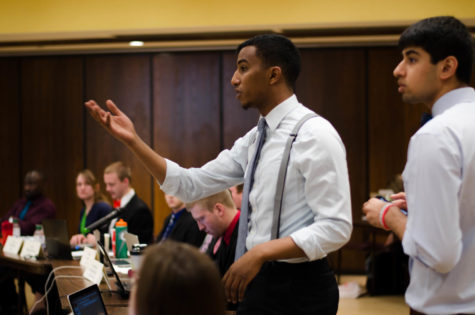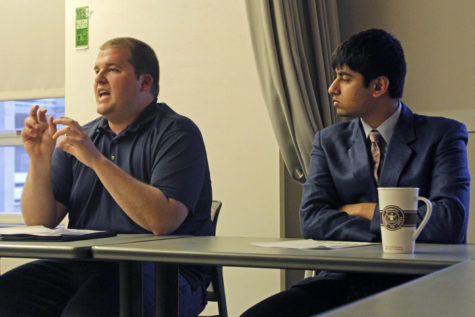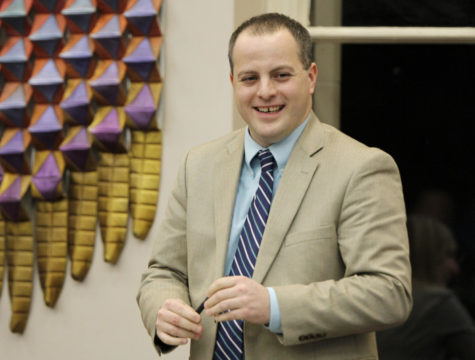A Cyclone Century
December 8, 1999
Editor’s note: This is the eighth article in a 10-part series examining significant events and the climate of the campus at Iowa State in each of this century’s decades. The stories are based on articles from the Daily during those time periods. Today’s article will look at the years 1970-1979.
The mood of the Iowa State campus as students entered the 1970s was even more violent and protest-laden than the late 1960s.
As American involvement in Vietnam continued to escalate, protests to the war also picked up steam. In May 1970, that steam came to a head on the ISU campus shortly after the killing of four anti-Vietnam protesters at Kent State University on May 4.
Campuses around the nation erupted in protest of the killings, and ISU was not an exception. On May 6, between 3,000 and 4,000 students took part in a demonstration that began with a memorial service for the Kent State students on central campus at noon. It did not end until a handful of protesters were treated to tear gas at the Selective Service Office at about 9 the next morning.
In between, students disrupted an Air Force ROTC training session and blocked traffic on Lincoln Way for hours as they marched down the street singing, “Give Peace a Chance.” Twenty-three students were arrested in connection with the rally.
With that Government of the Student Body-supported demonstration, the anti-war movement on campus began to build. It was at this point that ISU President W. Robert Parks was faced with one of his most difficult decisions in his tumultuous 21-year presidency.
Instead of canceling the largest student-run celebration in the nation for fear of violent rallies, Parks outlawed all weapons on campus during the Veishea of 1970 — even the ROTC color guard was prohibited from carrying rifles.
And when anti-war protesters joined in the Veishea parade on May 9 and 2,000 people gathered around the Campanile after the parade to listen to him speak, Parks addressed the concerns of the anti-war movement in what might be the most meaningful speech ever given by an ISU president.
“If the university is not concerned with deep human problems such as bringing peace, then what should it be concerned with?” Parks asked, denouncing the violence at Kent State and admitting that he, too, would like to see peace.
On May 11, Parks also announced he was urging professors to “work understandingly” with students who were actively involved in either protesting or supporting the Vietnam War (many other universities canceled classes during this time period).
A major confrontation between student protesters had been avoided. ISU had weathered the storm.
The other main student issue on the ISU campus during the decade was civil rights.
The days on campus in which civil rights were the most in the spotlight were, coincidentally, also in the spring of 1970. The confrontation between white and black students on campus began in full thrust on April 10, 1970, when self-proclaimed black militant Roosevelt Roby and white, two-time national wrestling champion Chuck Jean brawled at Red Ram, a bar on South Kellogg Avenue.
Shortly after the attack, Black Student Organization President Roy Snell declared there had been a history of wrestlers harassing African Americans on the ISU campus, and if even one more black student were attacked, “there is going to be war up here. I mean W-A-R war.”
The trial of Roby for assault and battery brought friction between the races on campus to an all-time high. (Jean pleaded guilty shortly after the incident.)
On April 28, the judge trying Roby’s case, John McKinney, discovered a bomb planted in his garage. The finger-pointing began immediately, with blacks insisting they were being set up, and whites (including McKinney) saying they believed black militants were behind the act.
But this was soon overshadowed on May 22, when a quiet spring morning was broken by the sound of a bomb exploding at City Hall with enough force to rip the jail cell bars apart. The bomb injured more than 300 people and had such a jarring, shocking effect on the community that threats of violence between the races almost immediately ended.
As with the anti-war protests, race relations became an issue on campus several other times during the decade, but it was during May 1970 that the feelings ran strongest and the tempers flared hottest.
Not all campus activity during the 1970s revolved around protests and violence, though. The decade saw heavy construction once again, and enrollment reached unprecedented levels, breaking the 20,000 mark and sitting at almost 22,000 by 1976.
The majority of the Iowa State Center, the vision of former president James H. Hilton, was built during the decade — including Jack Trice Stadium, Hilton Coliseum, Fisher Theater and the Scheman Center.
Other campus construction during the decade included Larch Hall in 1971, Town Engineering in 1971, Ross Hall in 1973, Schilletter Village in 1973, the College of Veterinary Medicine in 1976, the College of Design building in 1977, the Seed Science Building in 1977 and the Meat Laboratory in 1977.
And after the turbulent beginning of the decade, things began to settle down on campus. For all of the student activism, GSB was notably ineffective during the 1970s. Elections were plagued by mostly low turnouts, and the senate’s most prevalent actions during the time period was the constant battle to keep student representatives on university committees such as the Athletic Council.
The main campus issues of the mid- and late-1970s reflected the issues affecting the nation as a whole. Drug use, an issue that was shocking only years earlier when Don Smith was walking the sidewalks of ISU, had become a common topic by the 1970s.
A poll in 1973 showed that nearly two-thirds of ISU students said they could purchase marijuana without a problem or with very little problem.
The energy crisis also struck ISU, as students were urged during the latter years of the decade to conserve energy whenever possible and to try to mold their daily habits in to a more eco-friendly routine.
But a great deal of excitement during the 1970s came all at once, in a powerful single spurt of collective caring during the first two or three years of the decade. Students still were reflecting back on the events of years not-so-far past when they entered the 1980s.









